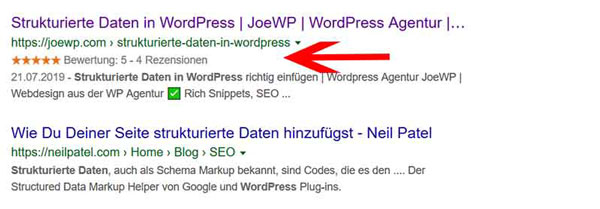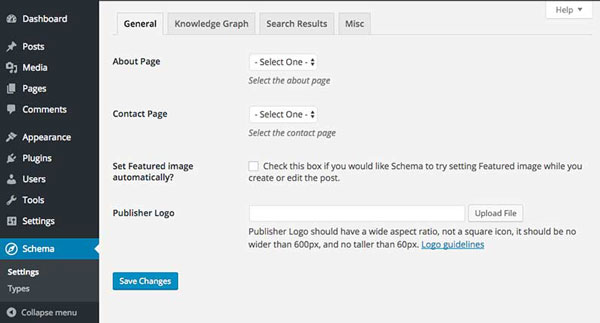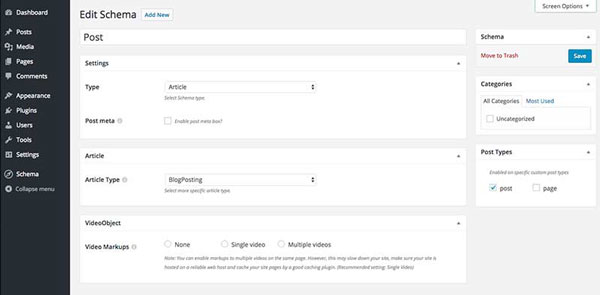Rich Snippets – Wieso jede Website Structured Data nutzen sollte
All website owners should ensure that search engines can properly index the content of their website. This goal is already achieved with the normal methods of search engine optimization (SEO). WordPress websites already have a great advantage in this regard, as they are an SEO-friendly platform by default. Features such as readable permalinks with talking URLs that make it easier for search engines to process content are usually pre-installed.
But what about the area of schema markups?
Features such as readable permalinks with talking URLs that make it easier for search engines to process content are usually pre-installed. Adding schema markups (also known as “structured data” or “microdata”) to the site can significantly improve Google’s ranking and click rate.
The preview (snippet) of each site usually consists of the title of the site, the URL, and an excerpt of the content. This is the default view.
You want to stand out clearly from this view?
Here’s how to do it. But before that still agree explanations with some basic knowledge of structured data:

Der obere Google Eintrag ist mit strukturierten Daten ausgezeichnet (Bewertungen und Inhaltsverzeichnis). It is already visually larger and attracts more attention than the website listed below.
#1: What is structured data and how does it help Google?
Structured data is currently “the hottest topic” in the context of search engine optimization. But what exactly is structured data? Why should I use Structured Data on my website? How to implement rich snippets? A set of questions that we want to answer here. We give you valuable tips for implementation.
With so-called microdata or structured data, certain contents of a website can be awarded, so that it is correctly understood by Google. This will then display them in the search results in addition to the above parts of a snippet.
Structured Data is a markup format. It gives website operators the opportunity to distinguish information. This allows search engines such as Google to use this information to enrich the search results. The following types are used, such as Person, Place, Product, Event, Organization, Review or Action. The formats for these are: RDFa, Microdata and JSON-LD. The implementation type recommended by Google is JSON-LD.
Google Search is hotly contested. If you catch the eye in the search results, you get more clicks and thus significantly more traffic. Until now, the optimization of meta descriptions and titles has used the possibility of increasing click-through rates (CTR). Google now offers so-called rich results (rich snippets) for individuality in the search results list and for ease of use. Rich snippets depend on the structured data implemented. Thus, these can be influenced and each website operator is responsible for whether Google displays them on search results pages.
#2: What are rich snippets and what are they good for?
Snippet is the name for a single entry in the search results list. Rich is the term for a richer and more advanced representation. This allows images to be embedded or other key data to be displayed directly in Google Search. For example, representations for products, star ratings or reviews can be embedded. For example, users of Amazon product pages see the star rating and the number of reviews. For example, an event website lists the next events. Structured data is also needed for the new Google job offers in order to be found in searches for “jobs near me”.
#3: What can structured data be used for?
A lot of different content can be awarded with structured data. A complete list can be viewed at schema.org.
The most important “schema types” can be awarded with the plugin scheme:
Reviews, Local Businesses, Articles, Services, Products, Courses, Recipes, People, Job Ads, Software, Books & eBooks, Events, Videos
Depending on the type of structured data, different content can be awarded and thus also displayed in the Google search results.
For services, for example, a price range can be specified, for books the ISBN and the format. Products can be provided with availability.
There are currently 600 different types and 870 related properties. The most important types are:
Type Event
This type is suitable for an event, concert, festival or the like. In addition to prescribed properties such as the name, date and location, there are useful additions such as the Property Offers property. This allows you to directly include ticket options that include the price and availability. A detailed list of the different properties for the Event Type can be found on schema.org/event
Local Business
The Local Business Type can be used to advertise local businesses and their attributes. These include: the address, the opening hours, the telephone number, the accepted currency, the price range. More information can be found here: https://schema.org/LocalBusiness
Type Product
The product type is there to present products directly in Google Search. The customer will be shown a Rating Overview with Star Rating, the specified price, currency, availability of the product, and a brief description of the item. You can find more information here: https://schema.org/
Often, there are error messages and warnings in the Google Serarch Console. Produkt Fehler in der Google Search Console sollten unbedingt vermieden werden. We have written another article that you should read about this: Fixing bugs and warnings in the Goggle Search Console
#4: How is structured data used in WordPress?
In WordPress, adding schema markups is a customizable process. It should be noted that some of this information may have already been added by your theme as well as by the plugins. In particular, plugins for SEO and breadcrumb navigations can include some structured data in the website without you noticing it explicitly.
Before you start adding markups, you should find out what might already exist in your content. Damit ist die weitere Strategie zur Entwicklung der strukturierten Daten besser planbar. With Google’s Structured Data Testing Tool, you can easily determine your website’s markup.
#5: How is structured data entered?
Structured data can be integrated in different ways. The implementation type recommended by Google is JSON-LD. There are also the following types of integration: microdata (HTML-5 specifications), microformats (HTML attribute class) and RDFa.
Integration via JSON-LD
JSON-LD is not only Google’s recommended implementation method, it is also easier to understand for less experienced users. JSON-LD is a JavaScript-based type of integration and does not need to be included in the HTML code of the web page. JSON-LD uses name-value pairs with linked data. This guarantees a clear assignment of the structured data.
Manually add schema markup:
Schema.org, you can also manually add up or use the Google Tag Manager. Google Tag Manager is more convenient. However, it is only compatible with Google.
Add schema markup via a plugin
The simplest integration is done with a plugin. There are various plugins for WordPress.
After completion of the entries, you should test the successful integration with the test tool for structured data.
Professionally add JoeWP’s schema markup
You can also have the schema markup installed by the JoeWP team in your own website or the WooCommerce Shop. We have a corresponding module in the shop: https://joewp.com/produkt/wordpress-schema-markup-modul/
Add schema markup via a plugin
After completion of the above tests, further improvements may be made. The easiest way works via the free schema plugin. This plugin supports custom post types.

It has some useful features such as enabling different schema types by category or post type. It is compatible with other plugins installed on the site such as Yoast. This allows you to use the markup you’re already using.
The plugin uses JSON-LD (lightweight format), which is recommended by Google. It currently has more than 60,000 active installations. However, the review markup is not included in the schema plugin, but can be extended via a free Schema Review plugin that adds this feature.
In order to install the plugin in WordPress, navigate in the WordPress administration to Plugins -> Add New and search for “Scheme”. Once the plugin is installed and activated, go to Scheme -> Settings to add markup to your site. Fill in the basics, such as the location of your info and contact pages, and insert a logo. Use the tabs to complete the setup. This step alone adds basic markups to your website.

Next, you should check out schema>types. Here you can add a custom markup to each post type or only certain categories if desired. Standardmäßig werden Einträge für Beiträge und Seiten angezeigt. However, you can add more. In the documentation for the plugin you will find some extended uses.

The schema plugin supports:
- Knowledge graphic (organization, logo, company contact numbers and links to social profiles).
- Creative work (articles, blogposting, newsarticles, report, etc.).
- Blog, WPHeader, WPFooter, BreadcrumbList, Info page, Contact page, Person and other WordPress elements.
- WordPress plugins from third-party providers such as WooCommerce, Easy Digital Downloads and others.
- Schema Review (via the above free extension).
The beauty of this plugin is that it also offers the possibility to define new editions of type schema.org. This is ideal for developers and designers who want to add support to an existing site for a specific type of schema markup.
#7: The Benefits of Rich Snippets
1. Rich snippets take up more space and appear more dominant and are therefore clicked more often than standard search results. Thanks to the optimized display, users are more likely to know what to expect behind a link. This increases the CTR (click rate) and lowers the bounce rate. Indirectly, structured data can therefore have a positive impact on the ranking of your website.
2. Extensive Knowledge Panel Information
3. Offer and price products & courses directly in Google Search. The Internet searcher gets more information about the corresponding website without having to click on it. As a result, significantly more people click on this website than others.
4. The content is better understood by Google and Google can better classify the website.
#8: Schema-Markup | WordPress-Plugin für bestimmte Nischen
With the plugins and methods mentioned above, you can create a very good markup scheme and even add your own types if needed. Es gibt jedoch verschiedene nischenspezifische Plugins, die sogar Markup-Schemas für bestimmte Datentypen erstellen.
We will look at some such plugins.
Event Scheme Plugin
The event schema plugin is useful for those whose website generates a series of events that must be marked as event tree data.
The plugin can also be integrated into common WordPress event plugins such as Events Manager, All-in-One Event Calendar, Event Organizer and EventON.
All-in-one schema rich snippets
Product-rich snippets and reviews are also a great feature you should have on your website. You generate better clicks on your website from the results pages at the search engines.
You can see below how rich snippets stand out along with your reviews in Google. Sie enthalten eine Sternebewertung basierend auf aggregierten Bewertungen, dem tatsächlichen Produktpreis und der Frage, ob das Produkt vorrätig ist oder nicht.
All-in-one schema rich snippets integrate with various types of WordPress content types, including the product, and generate a schema markup accordingly.
Schema validation
Our final recommendation will be for the generation of evaluations. This is especially useful for websites that sell products that also accept user reviews of the actual products or the actual products themselves.
For this special feature for viewing checks, we suggest schema validation by the same author of the schema plugin that we mentioned earlier in this article.
As you can see, you can optimize the review markup for individual posts. Dies basiert jedoch nur auf den Rezensionen des Herausgebers.
However, if you want to view customer reviews, you can suggest WP customer ratings to add customer reviews to your products and generate spending that reflects the markup scheme with aggregated ratings.
#9: Troubleshooting Schema Markups
After you set up the markup scheme, you can check your site using the Structured Data Test Tool.
It is important that your site does not contain any errors or warnings.
Übermäßige Fehler oder falsch strukturierte Markup-Daten können nicht nur für Suchmaschinen problematisch sein, sondern auch zu algorithmischen Strafen führen, die den organischen Datenverkehr auf deiner Website zum Erliegen bringen.
Multiple entries
This is by far the biggest problem we encounter with the markup scheme. With multiple plugins that support the generation of markup schemes, multiple plugins can easily try to generate the same data.
The result will be a tangle of data that comes from different locations and may generate conflicting or superfluous data.
If you see multiple entries for your organization, be sure to check the settings of the plugins that generate the schema. Then turn on those you don’t want to see.
Missing mandatory fields
This is also a problem and is likely to appear in the Google Search Console under the Structured Data report.
Correct missing mandatory fields by identifying the elements that cause the errors. You should then update or disable it.
Hidden schema markup
Some unscrupulous SEOs who want to force better placement in search engines have actually started to abuse the markup scheme by generating structured data for items that are not visible on the page or in the current browser. are not visible.
If you want to use the schema markup, make sure that the items that are marked are actually displayed on the screen.
If this is not the case, it violates Google’s policies. This results in an algorithmic penalty or manual verification that significantly affects your website.
#10: Google Knowledge Pannel
Structured data provides a more comprehensive representation in the “Google Knowledge Panel”. Among other things, information about companies, people or places is embedded there. These are collected and correlated by the Google Knowledge Graph. This is the structure for a network of semantically linked information. For example, the contact details, opening times, a section of Google Maps and social media profiles are recorded in the Knowledge Panel. This information can be enhanced by structured data around the logo, the service number or social media profiles. This increases the visibility of your own company.
# 11: Google Rich Cards – Structured Data for mobile search
Of particular interest are structured data in mobile search. The user has a much smaller screen size. So not so much information can be accommodated on the display as in the desktop presentation. Google uses different representations for different topics. As Google has recently focused on mobile search, the rich snippets have evolved into “rich cards”. Google also calls it Carousel representation. The user can scroll through them horizontally. Currently these entries are limited to the Type Recipe, Film, Course and Article. The Type Film (Media) is treated as special, as it is only possible with a partnership with Google.
# 12: Who can use rich snippets?
The following things are needed to create rich snippets:
1. access to the source code of your website, or
2. a plugin for rich snippets or
3. Google Tag Manager
4. Basic programming skills
5. Testing: Google Structured Data Testing Tool
6. Optional: Google Search Console
Tip: If you want to use Structured Data on many pages of your website, an automation is recommended, since otherwise the data for each website must be re-entered. This can take several days for large sites.
For the implementation micro data or JSON-lD should be used.
# 13: How long does it take to see rich snippets?
When you implement structured data, the content is not immediately served as rich snippets. When rich snippets are displayed, Google decides individually. The timing also depends on when the crawler (search engine bot) is active on your web site the next time. If you regularly publish interesting content, you do not have to wait long.
But we still have tips to possibly force this:
Tip 1:
The site should be re-crawled in the Google Search Console after the structured data has been added. Then you can finally check if the structured data has been recognized correctly.
Tip 2:
In the SERP’s check if it’s implemented there. If you are already ranked with a keyword and rich snippets are already displayed, chances are good that the implementation will work for others as well.
Conclusion:
In 2019, the use of structured data is a must have for successful SEO. If you have implementation issues and do not know exactly which awards are relevant to you, we are happy to assist you.

